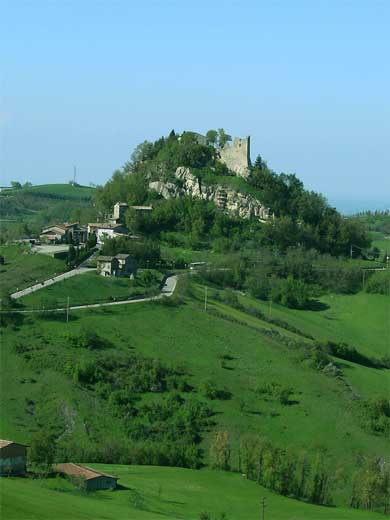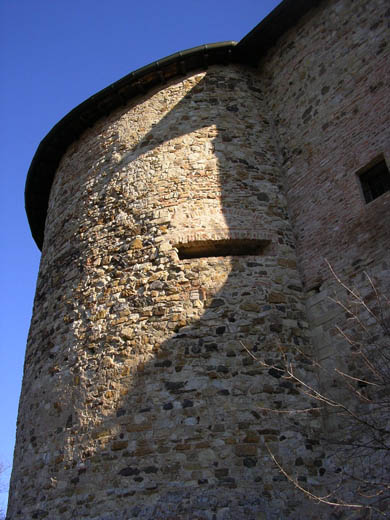Visiting castles
B&B La Fossa is the perfect base for programming a day tour for visiting the castles of this area. The closest castles are shown on the map below.
The castle of Torrechiara
Opening times: https://www.museionline.info/castelli-italiani/castello-di-torrechiara
Torrechiara is considered one of the most spectacular best preserved castles in Italy. The first castle was originally built in the 13th century but was later destroyed several times. The current castle is from the 15th century, built between 1448 and 1460 by Pier Maria Rossi. Its clearly defensive function is confirmed by 3 circles of walls and four corner towers but at the same time it is a romantic place, where Pier Maria Rossi’s love for his lover Bianca Pellegrini is celebrated. The castle preserves frescoes dedicated to her in an epic-chivalrous style. The Golden Chamber attributed to Benedetto Bembo and the bridal room stand out in particular for its beauty.
Kitchens, stables and various service and representation areas can also be visited. The nearby village at the foot of the castle is very well preserved.
The castle of Canossa
Opening times: www.castellodicanossa.com
The castle stands on a rock of white sandstone (from canus / bianco seems to derive in fact also the name of the same town of Canossa) and has a wide view of the surrounding valleys. The crumbling of the rock on which the castle insists resulted in the loss of about two thirds of the ancient surface. The original structure dates back to the 10th century. In the Matildic period the castle consisted of three nucleuses: the keep, the palace and the religious complex of Sant’Appollonio. After the Canossa it passed to various owners and during the various struggles, attacks and devastations it was often destroyed and then rebuilt. Today only a few ruins remain of the castle and only some of the rooms are still recognizable. The most identifiable area is that of the Church of Sant’Appollonio with the crypt: a large part of it has collapsed, while the northern wall is preserved because it was leaning against the fortification. Since 1877 it belongs to the Government and has become a national monument. In the area where the ancient palace was to have been built, the Naborre Campanini Archaeological Museum has now been built, which collects the finds and the remains found during the nineteenth century archaeological excavations.
The castle of Rossena
Opening times: http://www.appenninoreggiano.it/schede.asp?lang=it&d=castello-di-rossena
The Castle of Rossena stands on a rock of volcanic origin with a particular reddish color (hence the name of Rossena). The fortress of Rossena and the opposite Torre di Rossenella originally had military and defense functions of the most backward Canossa Castle due to the possible advances made by the Enza Valley.
From the 16th century this complex was transformed into a noble residence, as can still be seen today in the frescoes and decorations that adorn it. After the Canossa had various owners and today belongs to the Diocese of Reggio Emilia. Among all the castles of the Matildic period the Castello di Rossena is the most beautiful and the best preserved. Presents a series of concentric city walls.
In the park below stands the parish church of San Matteo. Following the path that leads to the parade ground where the keep overlooks, there is a series of environments including some dug into the rock in place, such as the cistern for water and prisons. Inside the castle it is worth visiting the “hall of virtues” and the Chapel.
The castle of Bianello
Opening times: www.bianello.it
The town of Quattro Castella remembers in its name the same number of castles that rose in the hills behind the town. Bianello is the only one of them that has survived to the present day and is the second castle to the west. Before the tenth century there was perhaps a lookout tower here. In the 11th century the castle already exists as documented by the contract of sale made by Beatrice, mother of Matilde di Canossa.
The various properties and vicissitudes through which this castle passed will profoundly mark its appearance. From the fifteenth century it was transformed into a noble residence and during the remaining centuries it underwent various restorations. Recently it was acquired by the Municipality of Quattro Castella. The complex has a closed polygonal shape where the various buildings have developed through successive joints. The entrance is accessed through a small and refined internal courtyard. Going up a baroque staircase leads to the noble floor where precious frescoes of the 17th century are preserved. Even the present furniture belongs to the seventeenth century.
The castle of Carpineti
Opening times: www.castellodicarpineti.it
The Carpineti Castle rises on the Antoniano mountain in a panoramic position between the valleys of the Tresinaro and Secchia rivers and with a wide view of the Reggio and Modena Apennines. Recently restored, it can be visited.
The fame of this castle dates back to the Matildic period when it represented one of the favorite residences of Matilde di Canossa and was also the site of important meetings that determined crucial decisions in the political landscape of that period. It presents a succession of 3 concentric walls that follow the longitudinal course of the relief. The structure of the castle is in fact the defensive castle-fence. Inside the walls are enclosed various buildings: the church of Sant’Andrea in the outermost area, the Church of Santa Maria (a sort of palace chapel), the palace, the keep, the cemetery.
At the death of Matilda of Canossa the castle changed several owners. In particular, in the 16th century it was held by the famous bandit Domenico Amorotto.



























